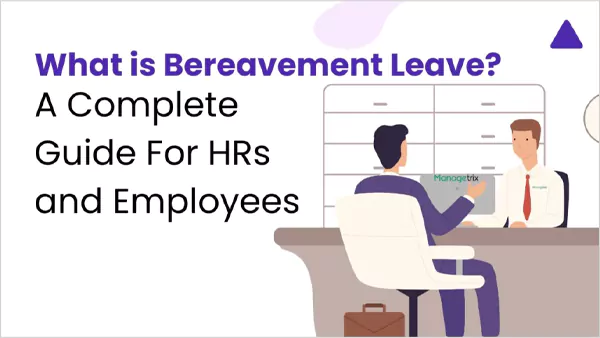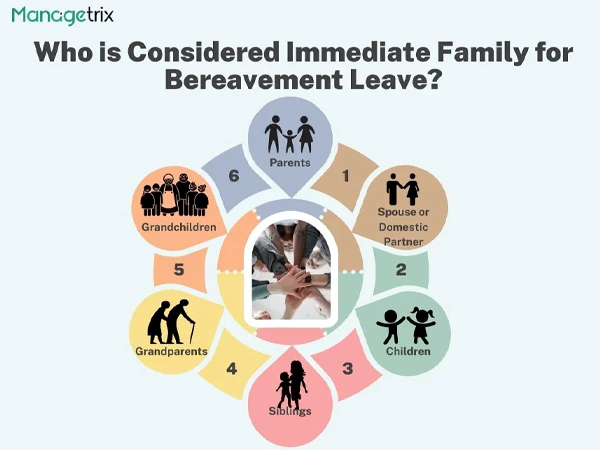
Managing work and personal relations has been the utmost challenge for an employee. For this, the organizations structure the policies that help the workforce in balancing these phases of life.
In such circumstances, the demise of a kindred person takes the employee to a deep emotional turmoil, which impacts their productivity on the job.
In such instances, bereavement leave serves as a suitable organizational instrument to provide relief to the employees.
But what is bereavement leave meaning, and how does it work?
So here we will discuss these leaves, the prime factors influencing it, who is considered a relative in such leaves, and other important dimensions.
Let’s get started.
What is Bereavement Leave?
Bereavement leave is a type of leave availed by employees who have lost a family member. It is to compensate the time off to that worker to manage the grief of the loss of life of a close family member to avoid impacting their work.
The format of applying for such leaves is similar to the ordinary format of writing a leave letter. But it must contain the specifics of which member you lost and for what duration you want to leave.
In contrast to some other types of leaves, such as VTO (Voluntary Time Off), which is generally unpaid, these leaves are paid for a limited duration as specified by the regulations of the firm.
Suggested Read: What is the LOP Full Form? Holistically Elucidated
Who is Considered Immediate Family for Bereavement Leave?

The relations considered immediate family for bereavement leave are parents, spouse, children, grandparents, grandchildren, and siblings. Let’s take a closer look at these relations and go through some precise details.
- Parents: Parents, whether biological, adoptive, or stepparents, are considered immediate family, as their loss deeply impacts an employee’s life.
- Spouse or Domestic Partner: A spouse or domestic partner is included in the definition of immediate family for bereavement leave, as they share a close emotional and legal bond with the employee.
- Children: Children, including biological, adopted, or stepchildren, are the immediate family of the worker due to the significant relationship and responsibility involved.
- Siblings: Siblings are recognized as immediate family because they often share a lifelong personal connection.
- Grandparents: Grandparents are included because they play important family roles, and their loss affects many employees deeply.
- Grandchildren: Grandchildren are part of the immediate family; a person is directly or indirectly responsible for their well-being, and their demise can have a deeper impact.
Besides these, some other relations are there which may or may not be included in the bereavement policy. These are:
- First Cousins
- Uncles and Aunts
- In-laws
After learning about these leaves, let’s analyze from the perspective of an employer what a bereavement policy must contain.
Regional Bereavement Leave Laws
The bereavement leave laws vary from state to state. Even the eligibility of the employers also differs significantly. This makes it very important for us to understand the local laws implemented to regulate such days off.
| S. No. | State | Laws |
| 1 | Washington | 1. Eligibility: All firms are required to provide such leaves. 2. Paid: YES 3. Criteria: For any family member or household partner, i.e., live-in relation 4. Duration: 3 days for general cases/ 10 days for child loss |
| 2 | Oregon | 1. Eligibility: Firms with 25 or more employees. 2. Paid: Unpaid (Unless firm’s policy) 3. Criteria: Death of a member of the family or extended family. 4. Duration: 14 days. |
| 3 | Illinois | 1. Eligibility: Employers covered under the FMLA (The Family and Medical Leave Act) 2. Paid: Based on the firm’s policy 3. Criteria: Death of parents, grandparents, stepparents, grandchild, children, siblings, spouse, or domestic partner. 4. Duration: 10 working days |
| 4 | Maryland | 1. Eligibility: Companies with 15 or more employees 2. Paid: Paid 3. Criteria: Death of parents, child, or spouse 4. Duration: Calculated under accrued paid leaves |
| 5 | California | 1. Eligibility: Companies with 5 or more employees must provide these days off. 2. Paid: As per the company policy 3. Criteria: Death of parents, grandparents, stepparents, grandchild, children, siblings, spouse, or domestic partner. 4. Duration: 10 working days |
What Bereavement Leave Policy Must Contain?
The bereavement leave policy must contain the fundamentals of the eligibility criteria for the leave, maximum duration, relations covered, and work management-related terms.
In this context, here are all the core and peripheral aspects of such a policy described in detail.
- Eligibility: The policy should clearly explain who can take these days off, whether it’s full-time or part-time employees, probationers, etc., so everyone knows who qualifies for it.
- Leave Duration: It must mention how many days off you can take and if that time is paid, so people can manage their paid and unpaid leaves.
- Relationships Covered: The policy should list which family members or close people are included, keeping in mind that families look different for everyone.
- Notification and Documentation: Employees should be told how to ask for time off and what proof they might need to produce to back their leave request, such as a death certificate, to make documentation easy for HR.
- Flexibility and Support: It’s important that the policy allows flexibility on when to take leave and offers support options if someone needs extra help coping with the loss.
- Return to Work: There should be some terms and conditions on how to return to the same productivity level at work after the leave, and sufficient arrangements for the employee required during that transition.
- Communication and Review: Making sure the policy is shared clearly and often updated to keep it fair and useful for the entire workforce.
Now you might be in a predicament about how to apply for these days off.
Here’s the procedure you can follow.
How to Apply for the Bereavement Leave?
The application procedure for the bereavement leave is similar to ordinary leave. However, it should carry some elementary details about the demise of which relative, how many days off you are requesting for etc.
Here is a detailed process of applying for these leaves.
- First, take a look at your company’s policy on these leaves to understand its rules and what paperwork might be needed for it.
- Inform your manager or HR team as soon as you can so that you’ll need some time off because of a loss, ideally by sending a quick direct message or email.
- Be clear about why you require the day off and roughly how long you expect to be on leave.
- If your company asks for proof, such as a death certificate or obituary, gather that to share with them.
- Complete any forms and formalities they require to make the leave official.
- Wait for your manager or HR to confirm your leave before taking time off.
- If you realize you’ll need more days, just let them know early and provide any extra documents they might ask for.
The above dimensions would have clarified for you what bereavement leave is. These facets correspond to some of its notable advantages, which are next to be discussed.
Advantages of Bereavement Leave
The advantages of bereavement leave are that it maintains work-life equilibrium, sustains employee productivity, helps them manage their grief, and builds a positive work culture.
Besides, there are some other advantages associated with such days off, which are discussed below.
- Maintain Work-life Balance: The most fundamental aim of providing such days off to employees is to enable them to manage their job commitments with their family duties.
- Helps Employees Overcome Grief: This leave helps the employee to continue and overcome the grief of losing a close one by providing them a brief time to settle down.
- Makes the Employee Return to Normal: This leave provides workers a gap from work and get back to the normal state.
- Builds an Empathetic and Reputable Workplace: When companies offer such leaves, it shows genuine care for the emotional situations of their workforce. This support not only creates a compassionate work culture but also enhances the organization’s public image, making it more attractive to potential talent.
- Reduces Presenteeism: Allowing employees to take time to grieve means they aren’t forced to work while mentally and emotionally drained. This helps ensure that when they return, they’re able to contribute fully with better productivity at work.
- Enhances Employee Morale and Loyalty: A supportive bereavement policy lets employees know that their well-being matters. This recognition builds a sense of trust and belonging, encouraging staff to remain loyal and engaged with the organization over the long term.
Conclusion
The information mentioned above and related dimensions will help you understand what bereavement leave is, how to claim it, and when you can request it. However, you are advised to learn the local regulations to ascertain who is considered immediate family for such leaves.
This will help you in managing the work-life balance in tough times and avoiding compromising work quality.
Next Read: What Is a Joining Letter? The Professional Template You Need to Make First Impression Count
FAQ
1. Is bereavement leave paid?
Ans: Bereavement leave may be paid or unpaid, based on the bereavement policy of your firm.
2. Are grandparents immediate family for bereavement leave
Ans: Yes, grandparents are considered immediate family for bereavement leave.
3. Can bereavement leave be used before someone dies?
Ans: Bereavement leave can’t be used before someone dies. It is generally requested after the demise of a relative.
4. Can bereavement leave be used for miscarriage?
Ans: Approval of bereavement leave for the miscarriage depends on the leave policy of the organization. While some allow it, others may disapprove of it as a legitimate ground to claim such leaves.